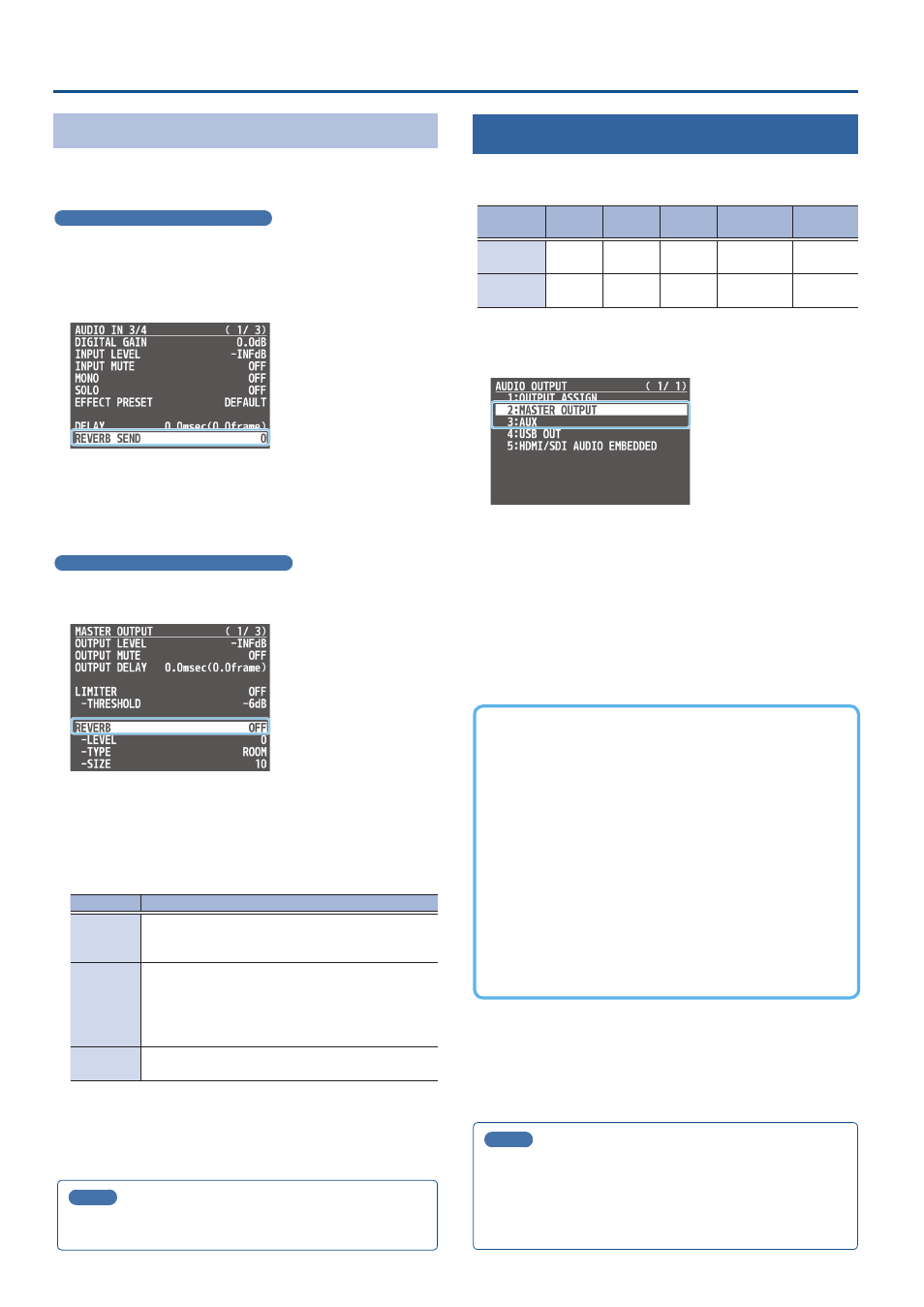Applying effects to output audio, Erb (p. 42), Applying reverb – Roland V-160HD SDI/HDMI Streaming Video Switcher User Manual
Page 42: Audio operations

42
Audio Operations
Applying Reverb
This adds reverberation to the sound.
* Reverb is not applied to the audio from the AUX bus.
Adjusting how much reverb to send
1 .
[MENU] button
Ó
“AUDIO INPUT”
Ó
select “AUDIO IN 1”–
“SDI IN 8,” and press the [VALUE] knob.
2 .
Use the [VALUE] knob to select “REVERB SEND,” and press
the [VALUE] knob.
3 .
Use the [VALUE] knob to adjust the amount of sound that
is sent to reverb (reverb depth).
4 .
Press the [MENU] button to close the menu.
Adjusting how much reverb is returned
1 .
[MENU] button
Ó
“AUDIO OUTPUT”
Ó
“MASTER OUTPUT”
Ó
select “REVERB,” and press the [VALUE] knob.
2 .
Use the [VALUE] knob to select “ON,” and press the
[VALUE] knob.
Reverb turns on.
3 .
Use the [VALUE] knob to select “LEVEL,” “TYPE,” or “SIZE,”
and press the [VALUE] knob.
Menu item Explanation
LEVEL
Specifies the amount of sound that is returned from the
reverb (return level). This adjusts the depth of the overall
reverb.
TYPE
Specifies the reverb type.
ROOM:
Produces the natural-sounding reverberation of
a room.
HALL:
Produces the reverberation that is typical of a
performance in a concert hall.
SIZE
Specifies the size of the room. The larger the value, the
longer the reverb time.
4 .
Use the [VALUE] knob to change the value of the setting,
and press the [VALUE] knob.
5 .
Press the [MENU] button to close the menu.
MEMO
You can assign the function to a USER button and turn reverb on/
Applying Effects to Output Audio
Here’s how to modify the tonal character by applying effects.
The following table shows the effects that are available.
Audio bus
Reverb Equalizer
Delay
Multi-band
compressor
Limiter
MASTER
OUTPUT
µ
µ
µ
µ
µ
AUX
—
—
µ
—
µ
1 .
[MENU] button
Ó
“AUDIO OUTPUT”
Ó
select “MASTER
OUTPUT” or “AUX,” and press the [VALUE] knob.
2 .
Using the [VALUE] knob, select the menu item of the
effect you want to use, and press the [VALUE] knob.
* For details on the menu items, refer to “10: AUDIO OUTPUT”
3 .
Use the [VALUE] knob to change the value of the setting,
and press the [VALUE] knob.
4 .
Press the [MENU] button to close the menu.
Á
Equalizer
This is a three-band equalizer. It lets you adjust the volume by
boosting or cutting three frequency regions.
Á
Delay
Outputs audio with
a delay. Delaying the output lets you correct
timing problems in the audio signal that is input to the output
destination device.
Á
Multi-band compressor
Applies separate compressors in individual frequency band.
Á
Limiter
Limits the output volume so that is does not exceed the specified
threshold level.
* Distortion will occur if audio that exceeds the allowable range of
the limiter is input.
MEMO
Adjusting the equalizer/delay for the USB output audio
For USB output, you can also apply equalizer and delay effects to
fine-tune the sound assigned to the bus.
Adjust the equalizer and delay parameters from the [MENU]
button
Ó
“AUDIO OUTPUT”
Ó
“USB OUT.”
